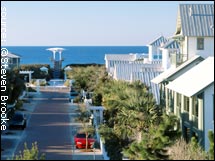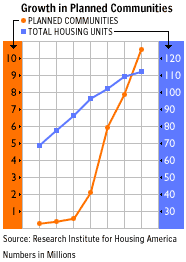
NEW YORK (CNN/Money) -
As fond as we are of big houses, big cars and super-sized discount stores, Americans seem to be growing weary of marathon commutes, suburban sprawl and indistinct neighborhoods. This sentiment has helped drive up prices in older neighborhoods, revitalize city centers and give birth to a growing trend in housing development – the planned community.
"Planned communities are a fairly successful idea throughout the Pacific Northwest," said Dana Bratton, a real estate appraiser with the Bratton Appraisal Group in Bend, Ore. "I'll tell you one of the reasons why – traffic. We're trying to reduce our road trips."
That is true for most boom areas. In fact, the number of single-family homes and townhouses within planned communities has grown from 265,000 in 1970 to 10.6 million in 1998 – 25 times the rate of housing units overall, according to a paper prepared for the Research Institute for Housing of America.
 |
|
| The planned town of Seaside, Fl. just marked its 20th anniversary. |
Once associated with gated retirement villages centered on golf courses and bingo halls, planned communities now come in all shapes and sizes and are attracting home buyers both young and old. Some are designed to blend in with established neighborhoods. Others ooze character (if that's what you want to call it). The town of Celebration, Fla., created by Walt Disney Co. (DIS: Research, Estimates), is as much a tourist attraction as the theme park. And Seaside, Fla., is so idyllic it served as the set for the movie "The Truman Show".
Neighborhoods incorporated
Planned communities, though difficult to define, do share some common characteristics. In every case, a developer buys a piece of land and devises a master plan for how the neighborhood will be laid out and, in most cases, what the common architectural themes will be. Homeowners not only own their houses and surrounding property, they often own partial interest in the neighborhood's common space as well.

All planned communities have a homeowners association, in which membership is mandatory. When buying property in a planned community, you agree to adhere to the association's covenants, conditions and restrictions (CCRs), which dictate everything from your paint choices to tree size. You also must pay monthly association fees for upkeep on amenities and infrastructure.
It is precisely because of these CCRs that some people abhor planned communities (too many restrictions, gimmicks) while others prefer them. "Most of the new housing developments here are in the form of a planned community, and I think that's because buyers are looking for the kinds of protections that come with a planned community's covenants," said Bob Schwent, a realtor with RE/MAX One in Santa Fe, N.M..
The price of paradise
Your property value is tied to your neighbors' regardless of where you live, but this is true to a greater extent in a planned community. For this reason, buying into such a neighborhood, particularly if it's a new development, may take a little more research.
For starters, you want to determine what kind of premium you will be paying to live in the neighborhood and whether it's worth the extra investment.
"You may pay more than what you would in a non-planned project, but that's because you're usually getting more," said Walter Carpenter, president of the appraisal firm Pinel & Carpenter in Orlando, Fla. Though some developers give buyers the ability to opt out of some amenities, in most cases the developer pays for bike paths, swimming pools and other amenities by adding it to the selling price.
You'll also want to consider whether the characteristics of the community will appeal to buyers a few years or decades down the road. The quality of construction and the policies of the homeowners association are two important factors to consider.
"I believe very strongly in the notion of planning," said Don Dorchester a real estate economist in Scottsdale, Ariz. "But only in so far as it's done right." He says that too many developers are more concerned with the immediate marketing of a property and not long-term value potential.
Will today's trend be tomorrow's kitsch?
According to research by the University of Southern California's School of Policy, Planning and Development, one third of housing consumers say they prefer neighborhoods with narrow streets, sidewalks and nearby amenities to those completely dependant on the car. In fact, houses in these kinds of neighborhoods are garnering a 5 to 25 percent premium over similar houses in other neighborhoods, according to research by the Urban Land Institute.
Of course, what sells and doesn't sell is largely determined by the local market and always susceptible to changing tastes. In Arizona, where much of the property is second homes, gated communities are still in demand because they seem more secure. In resort communities, amenities are a must, while in other areas developers are encouraged to donate land for schools and set aside green space.
Aside from considering the characteristics of the community itself, you want to make sure you don't pay a premium for a view that is eventually blocked by new construction or amenities that never materialize. "One developer out here in Arizona created a planned community that was a sell out but has been a battlefield since they finished the work. People paid $50,000 premiums for a view that has gone away, and the developer sold the golf course to an outsider," Dorchester said.
Even dream houses have leaky roofs
Quality architecture and construction are two things that never go out of style. Too often home buyers preoccupy themselves with superficial details, such as tile and carpet color, without worrying enough about the building itself, says Tom Miller, a building defects attorney in Newport Beach, Calif. This can be a problem with any kind of new construction but is particularly a problem when you rely on a mass-quantity developer to produce your dream home.
"There's a lot more opportunity for things to go wrong when you're building so many homes," said Miller, who has represented homeowners in three different lawsuits against Del Webb, a large developer of planned retirement communities. "In the interest of trying to hurry through to sell these homes they're making a lot of mistakes and cutting corners."
John Waldron, however, director of public affairs for Del Webb, said that doesn't paint an accurate picture.
"I would tell you it's just the opposite. Master plan communities attract top quality contractors and have the opportunity to hone the building process," he said. "We've built more than 6,000 homes, and Miller is representing just a handful of dissatisfied residents."
Nonetheless, construction defects in any home can take four to five years to show up and can range from peeling stucco to leaking windows and roofs. Soil problems, which can cause houses to sink, can take longer to materialize.

Miller says these problems arise when the soil is not properly tested or prepared, when architectural plans lack detail and when the developer subcontracts to the builder with the lowest bid rather than one with that will do the job properly. "Every development is different. It's hard to see who bad and good builders are," he said.
Although it pays to check into the reputation of the developer and the builder, Miller says it's worth the money to hire an independent inspector before you buy. That's true with any new construction.
If you're building a new house, you might consider having an inspector check out existing construction before you put any money down and then accompany you on your walk-through as the house nears completion.
Membership has its privileges and pains
Just as you should figure property taxes into your purchase decision, so too should you consider the association fees that go hand-in-hand with planned communities. These can range from $50 to several hundred dollars a month.
"Developers are now responsible for installing and maintaining such things as roads, sidewalks and light posts. That used to be the local government's responsibility," said Clifford Treese, former president of the Community Associations Institute and a consultant specializing in planned development.
Your fees pay for everything from upkeep of streets and sidewalks to garbage collection and amenity improvements. This is often on top of property taxes that, theoretically, are earmarked for many of the same things. In some places, including New Jersey, the government will refund taxes you paid on services performed by your association. In other areas you are stuck paying twice.
You'll also want to make sure that the association is managed well and has enough reserves to pay for unexpected costs. If there are not sufficient reserves, you'll be slapped with an extra assessment every time an improvement needs to be made.
Perhaps more importantly, you need to understand that your homeowners association can be your best friend or your worst nightmare.
On one hand, your homeowners association helps preserve the qualities of the neighborhood that appealed to you in the first place. On the other hand, if you don't understand the association's rules before you buy, you may be in for a rude awakening.
"If you're going into a community, you need to read the covenants to make sure you can live with it," said Jeff Bowling, president of the Appraisal Group in Atlanta.
In Celebration, Fla., for example, any window treatment that can be seen from the street must be white or off white and there is little tolerance for noisy pets. In many communities, you must keep your car in the garage and keep your lawn manicured.
"You really need to consider your lifestyle," said Treese. "If you move in and expect to park your RV in the driveway you're not going to be a happy camper when you find out you can't."

|

